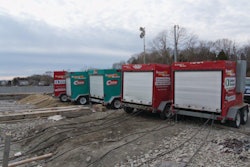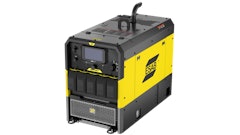
Generators can be indispensable for providing remote power to operate tools, lights, etc. on construction sites. And overall, they are a relatively safe means to do so. Yet, like any equipment, they can present safety concerns if used improperly.
Safe operation of any generator begins by reading the operator’s manual. The manufacturer is the undisputed expert on the equipment, and companies typically employ a host of personnel to evaluate codes, standards and best practices for their generator models. That said, it’s still important to be aware of the primary hazards associated with generator use.
Consult a Specialist
Accurately calculating power needs is critical to generator safety. Work with a specialist to ensure you have the appropriate generator for the application and conditions.
“Minimal thought given to power needs on any jobsite... can damage equipment and pose a major safety risk,” says John Garcia, manager, generator development Americas, Doosan Portable Power. “Properly sizing a generator can be complex, which is why we recommend that rental customers consult a power generation specialist before selecting a model for a specific application. The specialist will visit the jobsite and be able to identify power requirements, as well as potential needs for the future.”
Generator specialists can accurately determine the total kilowatts needed for specific applications, including whether one generator or multiple units will be required. The specialist will also be able to ensure proper maintenance and necessary safety precautions are followed, and install proper cabling and power distribution — a critical factor in minimizing accidents.
An electrician should make any hard-wired connections to a generator, advises Rick Bernier, national product application specialist/trainer for generators, heat, lighting and pumps at Wacker Neuson. “Wire connection order is: 1. Ground, 2. Neutral and then 3. line wires (hots). Removal is in reverse order.”
He warns, “Never back feed generator power into utility lines when connecting to a building. Always use a transfer switch to isolate utility lines from the generator. There may be a utility worker repairing the wires down the road. Also, if utility power comes back on…it will destroy your generator and may set it on fire.”
Never bypass safety features. “Do not make unauthorized modifications or component changes to the generator,” Bernier stresses.
Avoid Eectrocution Risk
Because the electricity provided by a generator is exactly the same as that supplied by normal utilities, it carries with it the same hazards for shock and electrocution. Post OSHA electrical safety Quick Cards and Fact Sheets around the jobsite as reminders. You can download them for free at www.osha.gov/pls/publications/publication.html.
Exercise extreme caution when operating a generator in wet conditions, and don’t ever set the unit in water. Keep power cord connection points off the job surface (grass, mud, etc). Start or stop the generator only when no electrical loads are connected, and avoid overloading the generator by trying to operate more equipment than its output rating allows.
Visually inspect cords. Make sure wires aren’t damaged or crossed and check to ensure they’re adequately insulated. Since overloaded cords can cause fires or equipment damage, check cord ratings so you don’t overload them by trying to draw more power than they’re rated to handle. It’s a good idea to restrict cord lengths to 50 or 100 ft. maximum. Avoid laying cords in high-traffic areas, and use cord ramps to protect them. Always assume wires are energized or could become energized.
You can run the risk of operator electrocution if a generator isn’t properly grounded. Grounding can be accomplished by driving a copper rod with a wire from the rod to the generator. The wire is then attached to a ground point on the machine.
Failure to properly ground the generator is the biggest safety issue with these machines, according to Nick Luciano, vice president, product development and compliance at MMD. “Almost no one does this on a regular basis,” he states. “Most rental companies do not even supply a grounding rod with their generator rentals.
“New generators are tested with a Hi-Pot dielectric test to check insulation strength,” he continues. “But with age, that insulation may break down and cause a short to the frame or covers on the generator, causing a shock hazard to the operator. Proper grounding will protect the operator from serious injuries or death.”
Some generators use an internally grounded neutral to the frame to ensure performance and personal protection. If in doubt, contact the manufacturer or dealer.
“If the portable unit is one of the smaller, handy, ‘pipe-frame’ or ‘hand carry’ models, they will most likely be fitted with voltage output receptacles, allowing the user easy interface, as well as protection by a ground fault current interrupting device, or GFCI,” says Jim Rose, director of sales, power equipment, at Multiquip.
For larger, trailer-mounted portable generators, however, the user is responsible for providing both an equipment ground, as well as a proper systems ground.
“The equipment ground is the conductor that runs from the generator ground to building service entrance main ground,” Rose explains. “The systems ground is the conductor that runs from the generator ground to an earth ground. The NEC (National Electrical Code) calls for one or two 8- to 10-ft. ground rods driven into the ground, with the intention of the ground rods’ net total resistance being no more than 25 Ohms. This will create a satisfactory low-impedance ground should a ground fault occur.”
More Safety Considerations
When selecting a generator, consider the available safety features. Many provide GFCI protection and covered outlets to minimize electrocution hazards. Some also feature additional guards, 110% fluid containment and emergency shutdown buttons and systems.
Other safety considerations for generator use include:
Proper ventilation. Because a generator uses a combustion engine, it gives off large amounts of carbon monoxide. As such, it’s important to ensure the generator is properly ventilated. Avoid running the generator indoors or in enclosed spaces of any kind, including garages, basements or crawl spaces. A well-ventilated room will not prevent the buildup of toxic gas.
When used outdoors, generators should be placed away from open-able windows and doors, as even prevailing winds can blow engine exhaust through the openings. In addition, a generator should always be placed with 3 to 4 ft. of clearance on all sides. This allows for air movement around the unit, which helps prevent carbon monoxide buildup.
Fuel-related risks. Under normal operating conditions, generators become quite hot. Pouring a flammable liquid on hot engine parts can cause the fuel to ignite. And while refueling a generator when it’s still warm — or worse, while it’s still running — might save a bit of time, it could put personnel in life-threatening situations. Make sure the generator is turned off and allowed to cool down completely before refueling.
Where the fuel is stored can also put operators in harm’s way. Flammable liquids should be handled and stored according to OSHA’s 29 CFR 1926.152 standard. This includes common-sense concepts such as not storing fuel indoors and storing fuel in properly labeled containers away from the generator and any other heat source. The heat from the generator can cause fuel vapors to ignite even in a sealed container.
Proper PPE. For those working near a generator, the noise level can be high enough to warrant hearing protection. Check the owner’s manual and manufacturer specifications to help determine if your model requires hearing protection. Keep in mind that wearing hearing protection when it might not be strictly required will not put anyone in danger and might help to protect you in the long run.
Wear other appropriate personal protection equipment (PPE), such as safety glasses, ear plugs, non-conductive gloves and shoes as required. Remove jewelry and wear tight-fitting clothing.
Physical contact during operation. Do not lean on generators or place objects on or against them. When possible, only one hand should be in contact with a generator. Make use of meter probe holders and insulated tools.
Also, be aware of moving and hot parts. Don’t put anything, including appendages, near the moving or hot parts of a generator or a compressor. Some models have a voltage selector switch on the inside of the machine so operators can’t change it while the unit is running.
Transport. While some generators are meant to be portable, they may still weigh several hundred pounds, so care should be taken during transport. Be sure to check local vehicle speed limits when towing and never drive faster than is safe no matter what the speed limit is. Use chock blocks when the generator is not connected to the tow vehicle.
Generators are an important tool to help you get the job done, and their use doesn’t have to be hazardous. If a generator is treated with the respect typically given to utility supplied electricity, the injuries to operators can be kept to a minimum.




















